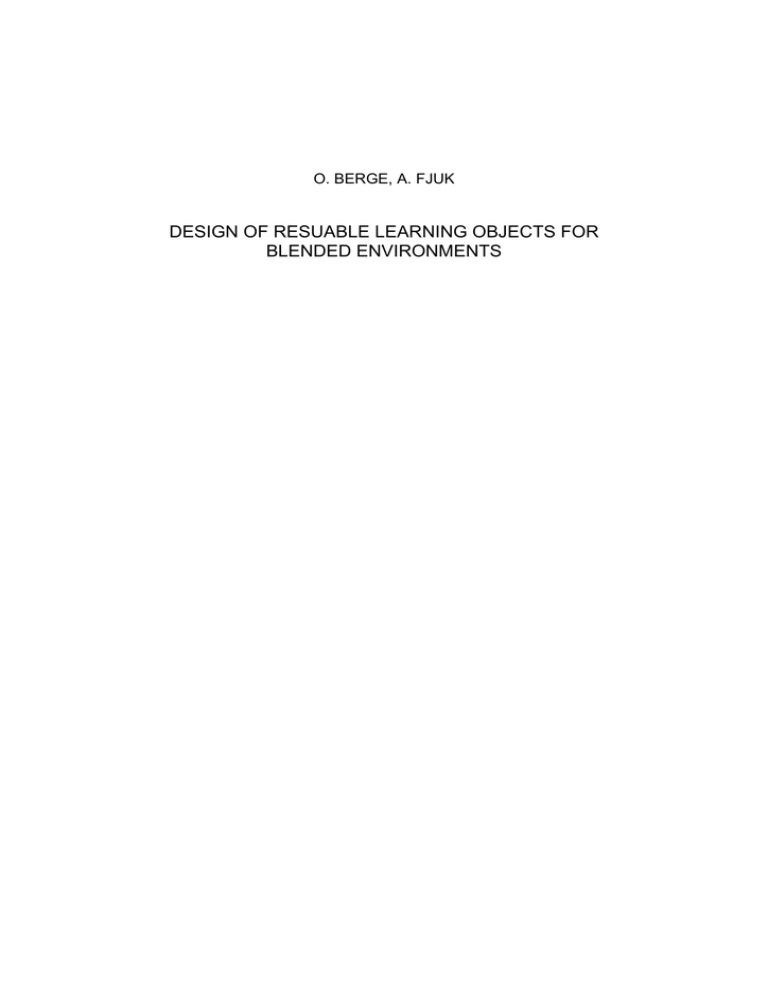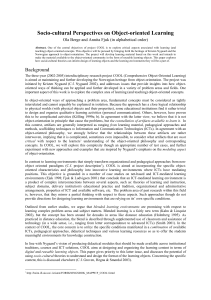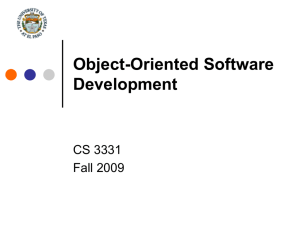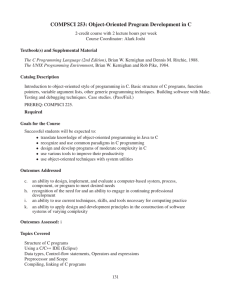DESIGN OF RESUABLE LEARNING OBJECTS FOR BLENDED ENVIRONMENTS O. BERGE, A. FJUK
advertisement

O. BERGE, A. FJUK DESIGN OF RESUABLE LEARNING OBJECTS FOR BLENDED ENVIRONMENTS 2 O. BERGE AND A.FJUK Abstract. The research presented in this poster is anchored in a problem area of learning and teaching object-oriented programming. With this basis, the poster presents challenges associated with design of digital didactical modules that are aimed at being incorporated into blended learning environments. Critical aspects are outlined from socio-cultural perspectives. 1. BACKGROUND Object-orientation has become a fundamental basis for many popular programming languages (e.g., Java) and systems design methodologies used today. Learning object-oriented concepts as well as lecturing about them, have however proven to be complicated activities. It is not object-orientation in principle that cause the problems, but the artefacts available to teach it (Kölling 1999). The programming languages used are considered too complex and the learning environment does to a limited extent supporting objectoriented thinking (Kölling 1999). Furthermore, the pedagogical approaches are often adjustments of approaches that are developed for non-object-oriented (procedural) programming (C. f. Nygaard 2002) and as such, offer the wrong set of tools and abstractions. In an object-oriented way of modelling the world, the fundamental concepts are considered as tightly interrelated and implies a consideration of a problem area from many different perspectives (C.f. Madsen, Møller-Pedersen, Nygaard 1993; Madsen 2002). We argue that collaborative learning approaches are particularly well suited for considering a problem area through multiperspective reflection and discussions of opposed alternatives. The three-year (2002-2005) research project COOL (Comprehensive Objectoriented Learning) is aimed at suggesting collaborative learning approaches that incorporate the specific condition of object-orientation as well as digital didactical modules on object-orientation (C. f. Nygaard 2002). This should be operationalised through learning environments that are situated across countries, institutional boundaries, ICT and didactical traditions. This poster presents problem areas positioned in this complexity. It gives priority to areas associated with the concept of reusable learning objects and how they should be considered in blended learning environments. 2. PROBLEM AREA Blended learning is a fairly new term (Kahn & Linquist 2002), but the concept has been around for decades in areas like distance education. A core concern is to utilize the specific conditions manifested in a combination of available ICTs, pedagogical approaches, didactical techniques and various learning resources so as to offer the students meaningful environments for knowledge construction. Digital learning material constitutes one type of artefacts that must have an essential position in the mediation of learning activity. A critical problem area in this respect is thus how the digital material – or the learning objects - should be understood so as to occupy a role as mediator for knowledge construction. LEARNING OBJECTS FOR BLENDED ENVIRONMENTS 3 2.1. Understanding reusable learning objects The concept of reusable learning objects (RLO) is a vital mechanism for obtaining the goals of the standardization efforts taking place in the e-learning industry. The fundamental idea behind learning objects is that instructional designers can build small (relative to the size of an entire course) instructional components that can be reused a number of times in different learning contexts (Wiley 2000). Learning content is broken down to modules, where the content of the module is described with metadata. A standardized approach to design of RLOs has the potential of achieving several benefits: the module can be used in different courses, it can be used within different Learning Management Systems, and it can be more easily updated than a larger block of content. The content in the RLO can be any element usually associated with multimedia content: text, graphics, animation, sound, movie, or a combination of these. The standardization initiatives’ choice of areas of concern seems to imply some assumptions about learning that are usually associated with a cognitivist perspective. An analysis of the actors behind these initiatives strengthens this impression (Hoel 2003). In project COOL, however, we seek to explore the potential of using socio-cultural perspectives (Vygotsky 1978; Engeström 1987). The unit of analysis is expanded to consider interaction between different activity systems, and the complexity we are dealing with increases. Using activity analysis to understand the role of learning objects in blended learning environments would include all use activities, ICT and tool producing activities, all teaching and knowledge construction activities, as well as changes and contradictions in the use activities (Fjuk & Ludvigsen 2001). In designs of learning objects the following questions are particularly interesting: How should the constellation of learning objects be designed to become a mediator for the learning activity? In this context, we aim at exploring the duality between the communicative and the operational aspect of human actions. First, this means how knowledge on object-orientation is best constructed socially. Second, it implies the conditions of metadata and standardization in the learning process. Closely connected to these issues, is: How and to what extent should the pedagogical approaches be incorporated into the designs? This means considerations on whether the designs should incorporate the pedagogical philosophy and as such, direct the use of the learning objects. Furthermore, it also means a consideration on an opposite approach, i.e, to only design for the object-oriented content, and leave the pedagogical philosophy to the organisational design. These questions will be focused through an experimental summer course (at University of Oslo, 2003) in object-oriented programming for novices. The insights achieved during this experiments will be thoroughly consider in new designs directed towards cases around the world. 4 O. BERGE AND A.FJUK Annita Fjuk is Associate Professor at Intermedia, University of Oslo, Norway and Senior Researcher at Telenor R&D, Norway. Ola Berge is Dr. Scient. student at Intermedia, University of Oslo, Norway and Research Scientist at Telenor R&D, Norway. REFERENCES Engeström Y (1987) Learning by Expanding. An Activity-theoretical approach to developmental research, Orienta-Konsultit Oy. Helsinki. Fjuk, A & Ludvigsen, S. (2001) The Complexity of Distributed Collaborative Learning: Unit of Analysis. In Dillenbourg, P., Eurelings, A. & Hakkarainen, K. (Eds.) ECSCL - European Perspectives on Computer-Supported Collaborative Learning. Proceedings of ECSCL: University Maastricht. Hoel, T. (2003). Standardization of e-learning (in Norwegian). In press. Khan, A.; Lindquist. K. (2002) Blended learning at a Leading Education Institute: State of Practice, elearn 2002. Kölling, M. (1999) The Problem of Teaching Object-Oriented Programming, Part 1: Languages, Journal of Object-Oriented Programming, Vol. 11 No. 8, 8-15, 1999. (PDF). Madsen, O. L. (2002) The Scandinavian School of Object-Orientation - in memory of Ole-Johan Dahl and Kristen Nygaard. http://oopsla.acm.org/oopsla2002/fp/files/spe.html Madsen, O. L; Møller-Pedersen, B. & Nygaard, K. (1993) Object Oriented Programming in the BETA Programming Language, Addison Wesley. Nygaard, K. (2002) www.ifi.uio/~kristen Vygotsky LS (1978) Mind in Society. The Development of Higher Psychological Processes. In . Cole M, John-Steiner V, Scribner S and Souberman E (eds.). London, England, Harvard University Press. Wiley, D. A. (2000) Connecting learning objects to instructional design theory: A definition, a metaphor, and a taxonomy. In The Instructional Use of Learning Objects. D. A. Wiley, The Agency for Instructional Technology and AECT.





